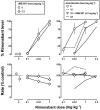The fatty acid amide hydrolase inhibitor URB 597: interactions with anandamide in rhesus monkeys
- PMID: 21449917
- PMCID: PMC3188916
- DOI: 10.1111/j.1476-5381.2011.01388.x
The fatty acid amide hydrolase inhibitor URB 597: interactions with anandamide in rhesus monkeys
Abstract
Background and purpose: The fatty acid amide hydrolase inhibitor URB 597 increases brain anandamide levels, suggesting that URB 597 could enhance the behavioural effects of anandamide. The goal of the current study was to examine and characterize the in vivo pharmacology of URB 597 alone and in combination with anandamide and Δ⁹-tetrahydrocannabinol (Δ⁹ -THC) in two drug discrimination assays in rhesus monkeys.
Experimental approach: The effects of URB 597 alone and in combination with anandamide were investigated in one group of monkeys (n= 4) that discriminated Δ⁹-THC (0.1 mg·kg⁻¹ i.v.) from vehicle, and in another group (n= 5) receiving chronic Δ⁹-THC (1 mg·kg⁻¹ 12 h⁻¹ s.c.) that discriminated the cannabinoid antagonist rimonabant (1 mg·kg⁻¹ i.v.).
Key results: Intravenous anandamide fully substituted for, and had infra-additive effects with, Δ⁹-THC. URB 597 (up to 3.2 mg·kg⁻¹ i.v.) did not substitute for or modify the effects of Δ⁹-THC but markedly increased the potency (32-fold) and duration of action of anandamide. The rimonabant discriminative stimulus in Δ⁹-THC-treated monkeys (i.e. Δ⁹-THC withdrawal) was attenuated by both Δ⁹-THC (at doses larger than 1 mg·kg⁻¹ per 12 h) and anandamide but not by URB 597 (3.2 mg·kg⁻¹). URB 597 did not increase the potency of anandamide to attenuate the rimonabant-discriminative stimulus.
Conclusions and implications: URB 597 enhanced the behavioural effects of anandamide but not other CB₁ agonists. However, URB 597 did not significantly enhance the attenuation of Δ⁹-THC withdrawal induced by anandamide. Collectively, these data suggest that endogenous anandamide in primate brain does not readily mimic the behavioural effects of exogenously administered anandamide.
© 2011 The Authors. British Journal of Pharmacology © 2011 The British Pharmacological Society.
Figures






Similar articles
-
Phenotypic assessment of THC discriminative stimulus properties in fatty acid amide hydrolase knockout and wildtype mice.Neuropharmacology. 2015 Jun;93:237-42. doi: 10.1016/j.neuropharm.2015.02.004. Epub 2015 Feb 16. Neuropharmacology. 2015. PMID: 25698527 Free PMC article.
-
Comparisons of Δ9-Tetrahydrocannabinol and Anandamide on a Battery of Cognition-Related Behavior in Nonhuman Primates.J Pharmacol Exp Ther. 2016 Apr;357(1):125-33. doi: 10.1124/jpet.115.228189. Epub 2016 Jan 29. J Pharmacol Exp Ther. 2016. PMID: 26826191 Free PMC article.
-
Apparent affinity estimates of rimonabant in combination with anandamide and chemical analogs of anandamide in rhesus monkeys discriminating Delta9-tetrahydrocannabinol.Psychopharmacology (Berl). 2009 Apr;203(2):219-28. doi: 10.1007/s00213-008-1230-8. Epub 2008 Jul 1. Psychopharmacology (Berl). 2009. PMID: 18592221 Free PMC article.
-
The endogenous cannabinoid anandamide produces delta-9-tetrahydrocannabinol-like discriminative and neurochemical effects that are enhanced by inhibition of fatty acid amide hydrolase but not by inhibition of anandamide transport.J Pharmacol Exp Ther. 2007 Apr;321(1):370-80. doi: 10.1124/jpet.106.114124. Epub 2007 Jan 8. J Pharmacol Exp Ther. 2007. PMID: 17210800
-
Discriminative stimulus properties of delta9-tetrahydrocannabinol (THC) in C57Bl/6J mice.Eur J Pharmacol. 2009 Aug 1;615(1-3):102-7. doi: 10.1016/j.ejphar.2009.05.010. Epub 2009 May 23. Eur J Pharmacol. 2009. PMID: 19470387 Free PMC article.
Cited by
-
Phenotypic assessment of THC discriminative stimulus properties in fatty acid amide hydrolase knockout and wildtype mice.Neuropharmacology. 2015 Jun;93:237-42. doi: 10.1016/j.neuropharm.2015.02.004. Epub 2015 Feb 16. Neuropharmacology. 2015. PMID: 25698527 Free PMC article.
-
Discriminative Stimulus Properties of Phytocannabinoids, Endocannabinoids, and Synthetic Cannabinoids.Curr Top Behav Neurosci. 2018;39:153-173. doi: 10.1007/7854_2016_24. Curr Top Behav Neurosci. 2018. PMID: 27278640 Review.
-
Screening Medications for the Treatment of Cannabis Use Disorder.Int Rev Neurobiol. 2016;126:87-120. doi: 10.1016/bs.irn.2016.02.005. Epub 2016 Mar 10. Int Rev Neurobiol. 2016. PMID: 27055612 Free PMC article. Review.
-
Inhibition of the endocannabinoid-regulating enzyme monoacylglycerol lipase elicits a CB1 receptor-mediated discriminative stimulus in mice.Neuropharmacology. 2017 Oct;125:80-86. doi: 10.1016/j.neuropharm.2017.06.032. Epub 2017 Jun 30. Neuropharmacology. 2017. PMID: 28673548 Free PMC article.
-
Comparisons of Δ9-Tetrahydrocannabinol and Anandamide on a Battery of Cognition-Related Behavior in Nonhuman Primates.J Pharmacol Exp Ther. 2016 Apr;357(1):125-33. doi: 10.1124/jpet.115.228189. Epub 2016 Jan 29. J Pharmacol Exp Ther. 2016. PMID: 26826191 Free PMC article.
References
-
- Adams IB, Compton DR, Martin BR. Assessment of anandamide interaction with the cannabinoid brain receptor: SR 141716A antagonism studies in mice and autoradiographic analysis of receptor binding in rat brain. J Pharmacol Exp Ther. 1998;284:1209–1217. - PubMed
-
- Castelli MP, Paola Piras A, D'Agostino A, Pibiri F, Perra S, Gessa GL, et al. Dysregulation of the endogenous cannabinoid system in adult rats prenatally treated with the cannabinoid agonist WIN 55,212-2. Eur J Pharmacol. 2007;573:11–19. - PubMed
Publication types
MeSH terms
Substances
Grants and funding
LinkOut - more resources
Full Text Sources

